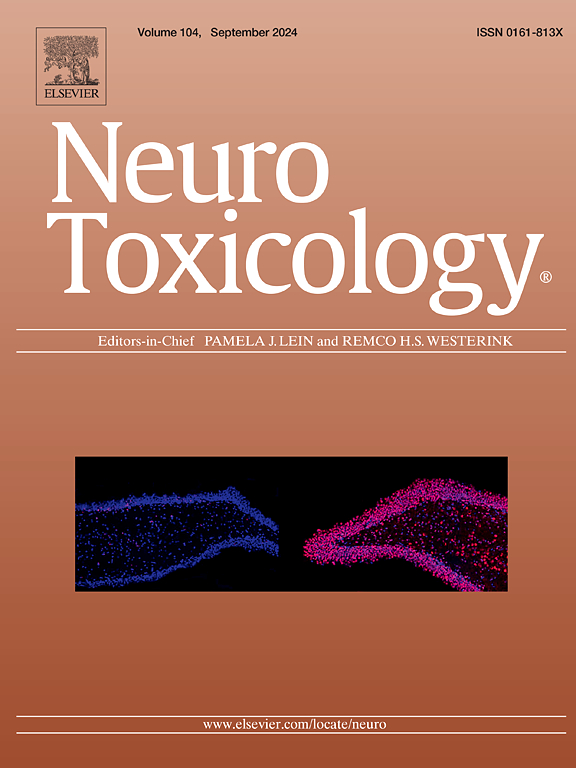Developmental neurotoxicity of bisphenol F and bisphenol S in animal model systems: A literature review
IF 3.9
3区 医学
Q2 NEUROSCIENCES
引用次数: 0
Abstract
Neurodevelopmental disorders have complex etiologies, stemming both from genetic and environmental risk factors, including gestational exposure to bisphenol A (BPA). BPA is an endocrine-disrupting chemical widely used in the synthesis of plastics and epoxy-resins. In 2012, the Food and Drug Administration issued a ban on the use of BPA in certain baby and childhood products, which contributed to the proliferation of BPA-free products. To make products without BPA, plastic and epoxy manufacturers often use chemical analogs, including bisphenol F (BPF) and bisphenol S (BPS). However, the structural and biochemical similarities BPF and BPS share with BPA suggest they may have similar molecular and cellular impacts on the developing nervous system, despite consumers generally regarding BPA-free products as safer alternatives. In this review, we synthesized all available peer-reviewed primary literature to date reporting on the neurodevelopmental impacts of BPF and/or BPS in animal models. In total, 61 papers were identified as relevant to the topic, including evaluation of BPF- and BPS-associated neurodevelopmental phenotypes such as changes in neurodevelopmental gene expression, the proliferation and differentiation of neural stem cells, synaptogenesis, central nervous system morphology, neuronal cell death, and behavior. Though less extensively studied than BPA, the collective works described here indicate that BPF and BPS can act as developmental neurotoxicants in animal models, urging further mechanistic and epidemiological analyses of these bisphenol analogs, as well as a reconsideration by regulatory agencies of policies surrounding their usage.
双酚F和双酚S在动物模型系统中的发育性神经毒性:文献综述
神经发育障碍有复杂的病因,源于遗传和环境风险因素,包括妊娠期暴露于双酚A (BPA)。双酚a是一种干扰内分泌的化学物质,广泛用于合成塑料和环氧树脂。2012年,美国食品和药物管理局发布了一项禁令,禁止在某些婴儿和儿童产品中使用双酚a,这导致了不含双酚a的产品的激增。为了制造不含双酚a的产品,塑料和环氧树脂制造商经常使用化学类似物,包括双酚F (BPF)和双酚S (BPS)。然而,BPF和BPS与BPA在结构和生化上的相似性表明,它们可能对发育中的神经系统有相似的分子和细胞影响,尽管消费者普遍认为不含BPA的产品是更安全的替代品。在这篇综述中,我们综合了迄今为止所有可获得的同行评审的关于BPF和/或BPS在动物模型中神经发育影响的主要文献。总共有61篇论文被确定为与该主题相关,包括BPF和bps相关的神经发育表型的评估,如神经发育基因表达的变化、神经干细胞的增殖和分化、突触发生、中枢神经系统形态、神经元细胞死亡和行为。虽然没有BPA那么广泛的研究,但这里所描述的集体工作表明,双酚pf和双酚ps可以作为动物模型中的发育神经毒物,敦促对这些双酚类似物进行进一步的机制和流行病学分析,以及监管机构对其使用政策的重新考虑。
本文章由计算机程序翻译,如有差异,请以英文原文为准。
求助全文
约1分钟内获得全文
求助全文
来源期刊

Neurotoxicology
医学-毒理学
CiteScore
6.80
自引率
5.90%
发文量
161
审稿时长
70 days
期刊介绍:
NeuroToxicology specializes in publishing the best peer-reviewed original research papers dealing with the effects of toxic substances on the nervous system of humans and experimental animals of all ages. The Journal emphasizes papers dealing with the neurotoxic effects of environmentally significant chemical hazards, manufactured drugs and naturally occurring compounds.
 求助内容:
求助内容: 应助结果提醒方式:
应助结果提醒方式:


